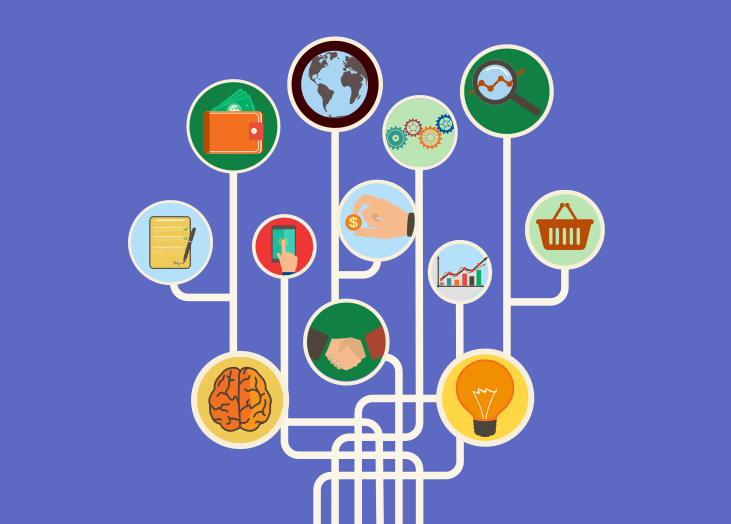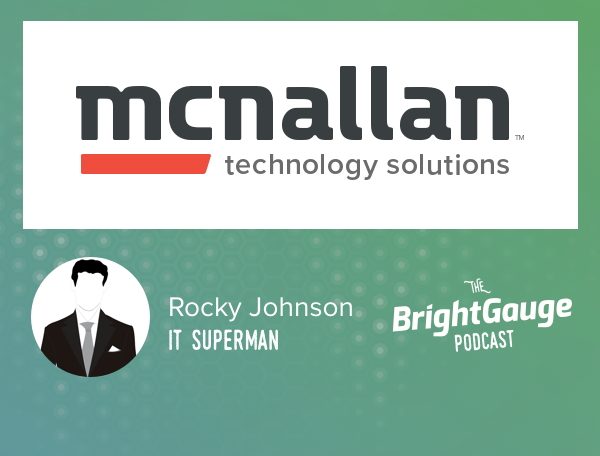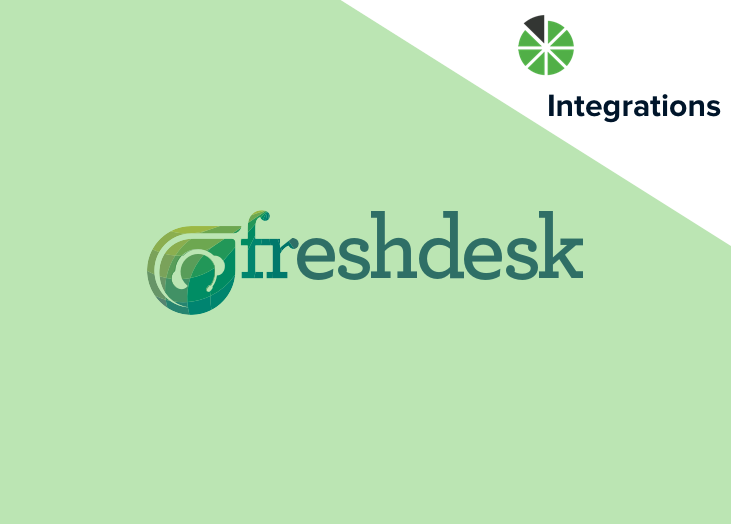Think about the night before you start a new job. You might feel nervous, anxious, excited, or apprehensive, riddled with questions like, Will they like me? Is this the right fit? Am I going to eat ...
Think about the night before you start a new job. You might feel nervous, anxious, excited, or apprehensive, riddled with questions like, Will they like me? Is this the right fit? Am I going to eat lunch all by my lonesome? Then, before you know it, you feel 100% comfortable at work. You even look forward to Mondays (imagine that!), knowing you can catch up with friends and dive into a new work week. Heck, you’ve even managed to get your coworkers to follow your random Slack channel! You try to conjure up feelings of the night before your first day and suddenly, it’s a completely foreign feeling. When and how did this happen? This, my friends, is the magic of effective onboarding. And I’m feeling it just two months into working at BrightGauge. Getting in the BrightGauge groove It’s been 66 days since I started at BrightGauge. I’ve learned a whole lot in just this short period of time. I love it here and feel quite lucky to have found this opportunity. A lot of BrightGauge users talk about how awesome it is to work with us on a personal level and I now understand why. What I’ve learned in two months This team kicks booty. We may be small, but we are mighty. Everybody here shares a strong work ethic and a passion for making sure our customers are taken care of. It’s easy to stay motivated. No one is wasting hours. We’re all respectful of one another’s time and spaces, and we all make an effort to stay focused and to put into practice the mindfulness learned from reading Cal Newport’s Deep Work. But, we love to have a good time. Have you ever just hung out at work past closing hours on a Friday? Because you want to? I wouldn’t have believed it 67 days ago, but when you get a great group of people together, it’s natural to gravitate towards friendships. A good bottle of wine never hurts. We don’t do meetings. Let me rephrase that. We try to avoid meetings as much as possible. These tend to take up a lot of unnecessary time and distract us from focused, deep work. Fewer meetings means more productive days. If we are to meet, we try to do it over lunch or in a focused 15-minute catch-up session. We’re not big on emails, either. This was wild to me at first. I couldn’t believe we weren’t expected to be tethered to emails 24/7. Instead, we believe in business organization and thorough documentation through tools like Basecamp and it’s a game-changer. Aside from having visibility into different teams’ projects (buh-bye, silos), using Basecamp boosts our team spirit, too. For example, every Monday, we all post weekend photos and anecdotes. It’s so nice to share these parts of our lives with one another. Everyone is willing to help. I do not have a tech background, so I love to ask lots of questions to really grasp the ins and outs of our software. My colleagues are my greatest resource for this. They are all patient, super intelligent, and more than happy to chat for as long as it takes to get my questions answered. I love that camaraderie. Constant learning is highly encouraged. BrightGauge places an importance on furthering one’s knowledge and passions by inviting us to attend industry conferences or even by switching internal departments. We are motivated to feel fulfilled and work optimally within our roles. We’re always on the lookout to ensure that the right person is in the right seat. We’re ever-evolving. Expanding our minds is just one piece of the puzzle. When it comes to making improvements on the services we offer, it’s all hands on deck. Every employee at BrightGauge is encouraged to pitch feature requests, discover and fix bugs, provide honest feedback, and look for new solutions. After all, we do actually use our own product. Good, valuable work can happen outside of the office chair. Yes, it can happen from home, from a coffee shop, from a co-working space, or from a chateau in France. BrightGauge encourages everyone to work remotely, especially since it’s been found to get your creative juices flowing and inspire new thoughts and ideas. I find it amazing that being committed to my work doesn’t mean relegating laundry to weekends only or having to miss out on seeing the world. Why our culture works for us Leadership. Brian and Eric Dosal founded BrightGauge on the idea that they could help make people’s lives a little better. That remains our focus and number one priority. Their vision has always been clear and they exude that in a way that’s contagious. Core values. People want to work here because we offer a really good service, with good intentions, surrounded by good people. It’s honest, straightforward, and humble work. Our team leads take a lot of time to fill available roles because the only way this will continue to work is if every single employee is committed to good-ness, in terms of relevant experience and fitting into our unique culture. Onboarding. A Basecamp feature we love is the ability to create to-do lists per person, team, or project. I’ve found that one really effective BrightGauge onboarding practice is that each new hire starts his/her first day with an already-set 90-day to-do list in his/her Basecamp folder. Talk about an awesome way to immediately make someone feel like he/she has purpose within a team. It’s a really simplistic example. Consistent onboarding processes go a long way in setting workflow and culture precedents. My (unsolicited) advice for you Stay true to you. Every business owner has a unique working style and a unique set of beliefs and values. There’s no need to compromise on that or to disregard it and settle for a conventional way of working. Operate the business you want to operate so you’re always honoring your truth. Have a process. Even if you have the most casual of laid-back work environments, have a process. Establish some rules. Be organized. Don’t be lackadaisical in your business approach because guess what? Your employees will be lazy in their approach, too. Track quarterly progress. Consider implementing Goals into that process. It helps employees to be accountable and driven towards success. Encourage work/life balance. Your employees live outside of their job. If they feel like their personal time is highly valued, they’re more likely to value their work time by being more productive and dedicated. Be good. This world is, frankly, saturated with mad and crazy people, events, situations. Why add to it? Operate with the best of intentions for all. I leave you with this oft-referenced Ferris Bueller quote: Life moves pretty fast. If you don’t stop and look around once in a while, you could miss it. This is true with work, too. Stop, digest what you’ve learned, appreciate where you are, and work really hard at being your best. Time - even at a brand new job - just flies by. Great employees are one way to improve your business, but setting the right KPIs can also make a huge difference. Download our free whitepaper, How To Improve Your Business With KPIs, for our tips.

What do you think of when you hear the word ‘job’? Probably a situation where you perform a specific task and earn a paycheck for it, right? There’s a different definition for ‘job’ and it can radically transform your business approach, making you more laser-focused and maybe more successful. It has to do with what life benefit your customer is looking to gain from using your service. More on this ahead. What about ‘marketing strategy’? What does that involve? Do you typically create a strategy based on target demographics? A buyer’s persona? As direct competition to a similar service that’s already being packaged by someone else? Do you focus on the service attributes itself? If you’re nodding your head, you’re not alone. Traditionally, we’ve been taught to look at marketing from this perspective. A lot of companies get their start by looking at an existing product or service and deciding “oh, we can do that better”. But what if we’ve been taught wrong? Another perspective exists and there’s a strong argument out there for changing your strategy. A different approach to marketing We’re talking about wholly shifting your focus to the customer’s emotions. What is the user’s situation? How can your service help them make progress in their lives? What job does the customer actually need your product or service to do for them? The argument is the theory of Jobs to Be Done (‘job’ meaning the progress a person is looking to make). It is not a new theory. It’s been documented in many books like a favorite of ours, Competing Against Luck, by Clayton M. Christensen. It has been applied by successful companies like Uber, Unilever, and Deseret News. Yet, many people are still confused by or unaware of it. To help put this theory into perspective, check out the commonly cited ‘milkshake theory’: At BrightGauge, we like this simplistic approach. While a little difficult to put into practice, we’ve found it helpful to look into how other companies are answering to the jobs their customers are hiring their services to do for them. Start by talking If you’re in the process of identifying the needs of your own customers, you may be asking where should I start? The answer is so obvious that it almost feels wrong. The best place to start is to talk to current customers. Ask brand new users what prompted them to make the switch from another service to yours. Don’t neglect recently churned customers - ask what caused them to leave. More likely than not, you’ll discover some incredibly helpful insights. You may even find your product or service is being used in different ways than you intended, which is not a bad thing! Quick example: Uber may have been started to help passengers have a great experience while getting from point A to point B, but the founders probably didn’t think some would use it as an alternative to owning a car. When talking to your users, it’s pretty important to get down to small, seemingly insignificant details. If you ask John why he hired an Airbnb rental over a hotel room and he answers, “it was a good price”, you can’t stop there. The fair cost is not the reason John is making progress in his life. What emotional value does Airbnb bring to John? With a little probing, you’d be able to discover that his true underlying need was to feel like he was actually living in the city he was visiting. He wanted to feel at home and Airbnb could do that job better than any hotel room. Before talking to customers, it might help to understand the typical timeline in a buyer’s decision process: Consider the ‘consideration set’ While you’re talking to customers, think about the emotional value your product or service brings. Keep the ‘consideration set’ in mind as you formulate new ideas for improving your service. That is, the other products that compete with your product. In John’s example, you might be tempted to think that all other Airbnbs or hotels in the market are the only existing competitors. Not true. Remember what he hired Airbnb to do (feel at home in a foreign city). Instead of an Airbnb, John could have hired a friend’s couch, leased an apartment, or done nothing at all. Conversely, he could fire his current home and move to the new city (kinda drastic, but not impossible). Don’t fall into the trap of believing you’ve got a service with zero competitors. You have to ask yourself if it’s really such a good thing to be on your own in the market. Is that an indication that your product is not a right fit? A little healthy competition is a good sign of future growth opportunities. It can be easy to think of products and services that are similar to your own, but it takes more effort to identify the less obvious competitors. However, this effort can lead to big rewards. The 5-Hour Energy Story Manoj Bhargava was perusing the energy drinks available at a tradeshow he was attending, in hopes of finding a pick-me-up. He realized the products on the shelf were too big - he wasn’t thirsty enough to consume a large energy drink. Also, he also didn’t want the extra sugar and junk commonly found in those drinks. He dreamt of a healthier and much smaller energy booster. When thinking about where in the supermarket to place it, he didn’t think it made sense to place it next to sodas, or water bottles, or other large drinks because customers needed a boost, not a thirst quencher. Instead, Manoj thought of the check-out area. Customers needed something convenient, quick, and that would help them have a productive day. Out of those needs, 5-Hour Energy was created. Chock full of vitamins and less than 3 ounces, it’s an effective grab-and-go solution. So effective Manoj is now a billionaire. Had Manoj thought to place 5-Hour Energy alongside Gatorade (an obvious competitor), the story may have turned out differently. Putting on a BrightGauge lens We are constantly exploring new ways to help our customers improve their lives through the use of BrightGauge. Through trial and error, plus a lot of talking to customers, we’ve come to understand that we’re here to help them easily see all their KPIs, impress their clients, and motivate their team. This all makes a really big difference to a lot of people’s businesses. Our work isn’t done though. Figuring out your product/service and the emotional value it delivers to people is just one piece of the puzzle. How do we apply this same frame of thought to other areas of business, like marketing? Base your communication on emotions, not features Every marketing strategy involves a lead generation campaign of some sort. If you’re not generating leads, you’re not gaining customers. No customers means no business. In today’s age of digital marketing, there are many tactics to choose from, ranging from pay-per-click (PPC) to retargeting campaigns to personalized emails. The method you choose is not as important as the message you put out there. So many times, you see ads that try to lure leads in by screaming “FREE Trial!” or “Lose 10 Pounds in 1 Day” (a.k.a., a totally unrealistic promise). Your customers are smarter than that. They will recognize click bait when they see it. With all the screens in their lives flooded with messages like that, how do you expect to stand out? Instead of focusing on shiny-gimmicky features, talk to customers about how your service will help them. Bring their emotions into the picture, because that’s what they will connect with. We like what Snickers has done. They’re not marketing themselves as “the best chocolate ever”. That’s just an unsubstantiated and very subjective claim. Their slogan is, “Hungry? Why Wait?”. First of all, everyone can relate to being hungry hangry. It makes you tired, cranky, moody, whatever. So, instantly a connection has been made. Secondly, they’re alluding that a Snickers can replace a meal. They’re helping their customers by keeping them full enough to get on with their activities and to last until dinnertime. Suddenly, Snickers is competing with a sandwich, and they become the best-selling candybar on the market. Genius. How we provide value through facetime We mentioned three key ways that BrightGauge helps customers make improvements on a daily basis. Working off of those insights, we realized that not every new customer is seeking the same solution. So, how do we communicate in a way that’s resourceful and truly valuable? We ask questions and we do it in person. BrightGauge is simple to use, but our users’ needs can get complicated. We like to take a hands-on approach to helping them find solutions. Through Data Driven Workshops or Customer Site visits, we ask our customers what they are looking for. Based on their answers, we tailor our demonstrations to provide the most value to each individual. For example, if a customer mentions that they are looking for a way to show their worth to their clients, we know we can help them gain more business through our reporting tool, which is a powerful way to build trust and credibility with clients. It’s more efficient for them because they’re getting comprehensive and valuable answers and they’re able to dive deep into our product. It’s helpful for us because face-to-face time goes a long way in building lasting relationships with quality customers. Plus, it’s fun for us! Take a new approach to your business plan If you’re trying to think of the next “big idea” or if you’re finding ways to strike gold, dial it back a bit. Take time to ask yourself “how can I make people’s lives better?” instead of “how can I create a super cool service?”. See where you can inject an extra bit of positivity into someone’s day, and hopefully, make them feel like a superhero for their team. It’s not really about reinventing the wheel here. It’s truly about making a positive difference in people’s daily lives. Consider the pain points that would drive someone to hire your service and fire the one they had already been using. Put yourself in the customer’s shoes and imagine the life events that cause you to take action in your own job. Remember: Job doesn’t always mean employment. It can mean progress being made in one’s life Consider a customer’s emotional, functional, and social situation - context and circumstance matter Your existing competitors may be in an entirely different product category Always use a lens of “how can I help my customer?” and not “look, what I offer is so pretty!” There’s a whole lot to learn about the Jobs to Be Done (JTBD) theory and, if anything, it’s an interesting lens with which to view marketing. We’ve found this site and this site to be helpful resources in learning more about this theory, but our ears are always open! How have you applied JTBD to your world?

Many have turned to Gino Wickman's book, Traction to help turn their vision into actionable goals. This episode's guest, Rocky Johnson of McNallan Technology Solutions shares what it was like to go through a company acquisition and how he's helping to foster team growth by extending leadership positions throughout the company. Sticking to something matters more than what you stick to. A bad decision is better than no decision. I jumped on Traction and thought this was it, the fastest way where I can get a small community and a leadership team as the book goes through, to create growth, and create challenges, and create really great arguments of, “Why did we do that? Let’s challenge it. Why did we do that? Lets challenge that. Top episode takeaways: A company 46 years in business scaling their team while staying true to what keeps customers loyal. Redefining and rebranding your company. Using Traction to build community, rotate leadership positions, and recognizing the capacity for change in others. Building employee loyalty -- "We don't punch clocks". Data Driven Workshops make data actionable while keeping it simple. Being super clear about the service you’re delivering. Want to find out more about The BrightGauge Podcast? Check out all the episodes here. _____________ Transcript: Brian: … Thanks for joining us. Rocky: Yeah, it’s great to be here, thanks for inviting me Brian. Brian: So, obviously we know all the speakers ahead of time. We had met a few months back at Data Driven workshop here in Miami. One of the things that I wanted to share with the listeners, is that the reason I quickly thought of you as a podcast guest, after we met, was you’re the only one in the group of the workshop, that kind of really grasped onto the simplicity concept of BrightGauge I remember someone was asking for some crazy chart type, and you were like, “Hey man, just do a number and do this filter and that’s it.” He was blown away and I thought, “I think Rocky just answered my question for me, thank god I love this guy.” You remember that? Rocky: I do, I do like the simplistic approach, the whole breakage thing and looking at numbers, parallels a lot of the Traction side of the business that we run here at my company. Simplifying that data has really garnished a whole lot more power, and glancing at a dashboard, knowing what you need and moving on rather than focusing on it for a long time. Brian: Yeah, I was like, “Like minded people here.” Then we had a few drinks afterwards, so anyway. Thanks for coming on the podcast. Tell us about yourself, and McNallan, a two minute history on the company, what you guys o, in that sense. Most listeners are in the IT services space, so feel free to use the jargo that you would normally use talking to peers. Rocky: Awesome, I’m from McNallan Technology Solutions, my name is Rocky Johnson. We’re a 46 year old productivity company. We started doing IBMs electric service in 1971. And moved pretty linearly through technology, like calculators because yes, it was technology, via the likes of ply ribbons and paper and that sort of stuff. Printers, copiers, IT, cloud. All that stuff. Most of our MRR now is managed IT and cloud hosting, but because we’re such an old company, we have the straggling break fixed, blocktime type accounts that have been with us for decades, that’re really hard to migrate. Brian: What’s the size of the company now? What’s the structure of it, services folks, vs non-services? Rocky: We have 23 employees currently. We have positions open, it’s a fun dynamic to keep and retain the people you really enjoy. We have 15 dedicated engineers, so the rest are three technical account managers, three admin staff and then two multi talented idiots that poked their heads in to the business. Brian: I don’t think you’re 46 years old. You joined the company, what’s your position? Give us that background too. Rocky: For sure. It’s a second generation family business. I’m not family, and I actually sold my business to McNallan and have bought in. So I’m a partner in this company now, I’m currently COO and will take this over as time goes on. It’s been here for a long time, it’s changed a lot of dynamics. It’s been a lot of fun to be a part of company sale and move forward and then get excited about the future. Brian: When was the sale of your company? Was it a merger sale? How do you describe it? Rocky: We describe it as a merger as it’s easier on liability concerns when we brought over accounts, and how we transitioned, licensing and all that kind of stuff. Technical term is, I received money for my portion from Ibeta Data, and value oriented contract so that I stayed on board to make sure that those customers stayed on. It probably was a conversation, maybe a six month transition where I brought it up, because I was in a real estate vertical, and it was tanking in 2007. When we moved, it was great because we had a long running relationship, I actually had a nine year history of McNallan as my customer, and I was doing hire, implementations and migrations for them when they were a little bit new in some of the corporate network space. So it worked out pretty well for me to come on board, get them more sophisticated clients, and then was able to give me the scope and exposure of a huge customer base. I mean, scope of a 46 year old company that stuck to their guns is incredible. We had thousands of customers a year that we dealt with. It was crazy. Brian: We didn’t talk about this too much in Miami, you had merged with them how long ago, from now? Rocky: I’ve been here ten years, we merged exactly ten years ago last month. Brian: And then how many people did you have? It was just a small shop, you and a few other folks doing high end — Rocky: Yep. me and just three other folks that did a real estate vertical. Did kind of a one stop shopping, we did IS programming and IT stuff, all that kind of infrastructure benefits that come along with this small environment where you can manage all that, but was a slow growth environment so was awesome to come on board to greater capital. Brian: So you had a sense of the family, knew the companies, basically a subcontractor if you will, or they outsource projects to you. Rocky: That’s exactly right. Brian: Joined and then the evolution to becoming COO, was that immediate? Or over time for you? Rocky: It was over time, my contract was fairly short. I didn't really know if I’d stay on long terms, I had pretty frank conversations. I know that you’re used to my conversations, I say what’s on my mind. So, after six months to a year, once my contract was coming to a close, I had a conversation and said, “I can double your service revenue in like three months, there’s not a problem with that, but I could quadruple it in six months, where do you want to go with this business?” It hasn't grown for a long time. So it was more of a rocksteady, the currents flowing, everything's good, it just wasn’t going in any kind of double digit growth. Brian: They had services back then? Was it like a traditional var, just recent stuff, or was it some services that you were blown away by? Rocky: They had a pretty good block time, so what happened was the company was very product oriented and product-centric. So they sold you a printer or a computer, it’s like free install, because people were cheap and equipment was expensive. That was the market they came from, so the first network that they put in was like, “Yeah, we’ll put in this nouvelle server and we’ll install it for free.” Think about that concept, that’s asinine. So, they really at a hard time, changing their customer understanding saying, “You have to pay for this service, because that’s really what you’re getting is brain power, anybody can sell you a product. They had blocktime accounts, these prepay accounts, a lot of loyalty, ridiculous amounts, 20 years history of doing services from fixing typewriters to fixing problems with Windows 95. We spent time saying, “Hay let’s write down what we are doing, let’s bill for this time, let’s talk to the customers to make sure they’re on board.” 100% were on board. We actually went from a small one user ticketing system, where people wrote down work orders by hand, technology company writing work orders by hand, and I built — Brian: This is in 2007 is it? Rocky: It was, it was probably ‘05 when they were still doing that. When I came on in 07 they bought Tiger Font. But they only had one licence, so they had four engineers at the time that were writing down things, in 2007.So the potential was huge, it was like, “wow, look at all the stuff I can do.” If I can just give them the ability to write a ticket on their own, can you imagine how many more billable hours we’re gonna see? It was fun. Brian: Thats awesome, so you were the next coming so therefore I can see the evolution for your becoming COO. What part of the country are you in? Rocky: We’re in Minneapolis. Brian: Okay, is it a crowded space over there? What’s your take on it? Rocky: I’m gonna say no. it’s really not that bad, not that I’m inviting everybody to come out to Minneapolis to compete with me, but -- Brian: Very busy. Rocky: --but, yeah it’s ridiculous. We have a few handfuls, so we’re really small business niche. We love where we’re at. We’re a hundred computer users or less. We do it well. We live it. We have a lot of customer base that we can pick from. We have competition in our exac space. We literally have competition with the same birthdate of company. They’ve been along the same evolution we have. Which is superbly unique. But we all work pretty well together and there’s a lot of space for us to fit in. There’s really only a handful of players in this business, with a whole bunch of one man bands and three man shops which, really we don't compete with directly. Brian: Gotcha, okay. It’s surprising with a big city as Minneapolis is, that there’s .. I’ve always found, at least the last 12 months, talking to customers especially at the workshops, everyone is doing really well. Either it’s the economy, people are valuing technology, especially with security and privacy all around. It’s great to — Rocky: I agree, I think there’s a huge opportunity for people to distinguish who they are and gain that loyalty, gain market share. We’re growing organically within our customer base so well, that reaching out to new businesses hasn’t been a high priority as, “Hay, let’s get the customers to pay for the services that we’re giving them.” Brian: I didn’t hear, you said the sales person right? Rocky: Yeah, we have three sales people. Brian: Okay, gotcha. Rocky: Technical account managers and all that. Brian: But the technical account managers, that’s their title? Rocky: Yep, they’re IT account managers, they do the sales process a lot of what we’re doing sells itself. Brian: -- hunting for new business, they’re the ones doing it too? Or is that just more rainmaker sale, the owner or the families, something like that for leads? Rocky: Yeah, it’s more managing accounts than the sale side. We had two people that really do most the sales. Course I’m part of that for influencing traits, and then we have another, the actual owner Mr McNallan that does a lot of that stuff too. He and I are responsible for bringing on some of the new stuff and we both enjoy that space. Brian: Makes sense. So we had a family business for a while, my father started in 1980, it was very similar evolution of technology. He was a salesman by trade, that was his bread and butter. We always found sales were easier when that person was involved, but we needed a technical person, it was very similar. To fast forward now, to the meat of it, last two years SEO, how has the business been for you, what challenges have you faced? What’s top of mind for you these days for the company? Rocky: Well our challenge is the stigma of being a printer company through an advertising age. We have a pretty good recognition in our area as being value oriented, small business, get your copy kind of place — Brian: - like buy your machine or all your printing needs as well like signs and stuff like that, just the actual technology behind it. Rocky: Just the technology behind it, we don't do the physical printing. But we have this connotation that we do networking. Well, no. We’ve done networking since 1980 but we haven't pushed that. We’ve let customers ask. So we went through a rebranding process two years ago. We redefined the company, redefined what kind of customers we would take, redefined how we talk to our customers, redefined our entire service desk. Really changed everything we thought we could change to be unique but still give that historical loyalty the benefit of the doubt in all of our conversations. So, all our migrations have been slow, but we’ve done it for a reason. We’re being respectful to those that need it. We’ve grown excessive percentages every year that we haven’t really needed to step on too many toes. Brian: Who led that charge? Whos idea was it to rebrand? Was it coming from you, the family, who pushed that job through? Rocky: It was a long struggle, that was on me. There’s a lot of challenge here where becoming greater percentage owner, as every year goes on, and being part of that. Knowing what next steps are gonna be, we have conversations we have Traction meetings, and I led that charge. It didn’t take long, you can give a sample group, and have conversations, and hire marketing company to blind interview your customers and ask the questions to go, “Wow, this would be great for you guys, I had no idea you did this.” After five conversations, with five good sized customer that had been with us 20 years that had no idea that we were cutting edge for stuff. It bloomed from there. Brian: So you drove a lot of that stuff, and you said the term Traction, what is your involvement with EOS, most the listeners would know, we’ll put in the show notes what EOS Traction is exactly, but when did you guys adopt Traction and EOS? What’s your history with that program? Rocky: In Minneapolis we’re in Hennepin County, Hennepin County did a grant, to build a second generation business growth group. It was a specific grant looking for second generation business to grow. Most of them become very stagnant once second generation happens, as you can get all these grants for new businesses. This specific push was all Traction oriented. So they invited a bunch of CEOs who showed up, our CEO went. Went to maybe six weeks of this four years ago, and said, “Hey, this is interesting, this has a lot of parallels that are key to what you’re talking about. Why don't you read the book.” I’ve read dozens of self help books, I’ve read dozens of how to run your business. I’ve started, my first business I was fifteen, I did a car audio shop in a store near my school, I’d bike to it. I’ve had a ton of businesses and I love this stuff. So it was fun to read and go through it, I thought you can read zig zig and get up in the morning and say, “Hey, today's going to be a good day.” You believe that stuff, if you stick to something you believe it. Brian: Right. Rocky: So, not to downrate Traction, but I more believe that sticking to something matters more than what you stick to. A bad decision is better than no decision. Traction gave us that Traction as a great metaphor, where I just said, “Yeah, I like this idea.” And I jumped on it and thought this was it, the fastest way where I can get a small community and a leadership team as the book goes through, to create growth, and create challenges, and create really arguments of, “Why did we do that? Let’s challenge it. Why did we do that? Lets challenge that.” We built, based on issues, based on people, based on continual, effective meetings, level tens and the EOS has been awesome for us. We’ve done well with it for over three years, it’s transformed out business. Brian: Wow, and then did you have a EOS coach when you first started? Rocky: Yeah. We didn't get one. Because, have you met me? I don’t need that. I ran everything through and gave all of that, forced it, pushed it, gave accountability and because of my excitement in the process, it really rallies the troops, we didn’t need a third party to say, “Rocky you made a bad decision, let’s move on and build the new decision for how we create the new solution.” I’m more than willing to fall on my sword and admit help, I don't have any problem with that. Let’s keep moving, let’s have some better ideas because I don’t know it. Brian: Looking back on it now, three and a half years ago, what would you recommend for others? In our community, couple hundred listeners that would be using Traction, or would not be using Traction I should say. What tips would you provide them, looking back on your own experience of doing it on your own, here? Rocky: Its an awesome question, because it really does resonate with a lot of the business owners out there. So if anybody is close to owning it, or even just feels like they want their business to go forward. Traction has an idea of a community, or a leadership team, in our case we take rotating positions. I pull a different service member, depending on their needs of the six month period, or a different sales member, and we create different leadership teams over the years, so that we have more feedback. What that gives is a vision and really a good sounding board, where the community and your company feels like its contributing to the growth of a company. Thereby increasing loyalty, and increasing all these things. One of the tricks that we’ve done, as an IT company. I hand out Traction books to most of our customers, and we’ve actually grown measurable from those customers, because they've adopted it or at least they’ve had some checkered balance. So, my advice for people considering taking it on, is don’t be shy to try, even if it’s 3%, you read it and go, “Gosh, I’m going to pick up one thing.” If you pick up that one thing, it’s going to make you trust the book and you’ll do everything else. Brian: Yeah. Rocky: It’s not like you’re gonna read 500 pages and feel like you’ve gotta do it all. Brian: I remember reading Traction, again for the ten second overview of what this EOS, entrepreneurial operating system is, Traction is the name of the book that this gentleman Gino Wickman wrote. A great foundational system in how to run a small company, that’s the basic way to call it. When I read it a year and a half ago, Rocky and I similar, I also said, “This is a lot of concepts regurgitated and consolidated into one group, it makes sense, so let’s just rock with it.” If we’re gonna believe it and stick with it. It’s phenomenally simple, it’s comprehensive and so a lot of small businesses that are using it have been very successful with it. We have three different companies, my brother and I, one of them being a cabling company that implemented it themselves, they needed to implement that consultant. So EOS has this great business model, they have consultants that help you through it. One of the things that I found very similar to you is if you just read a few chapters, if you implement a few of the things it’s a game changer. They have a lot of the processes that a small business can either forget about, or ignore, or just not want to think about because they’re busy doing other things. Rocky: And they can’t be afraid to. There are two big parts of this that I’ve told a lot of my customers, one is the people side, you can’t be afraid to recognise that people are gonna change. You have a lot of history and loyalty to these people, but you know what? They might not be the right person for the company, or they may not be in the right seat for your company. You have to recognise that people who don't follow your values, you can’t be afraid to trust the company. You’re putting food on many families plates here, you can’t let one person burden that possibility that another employee can't get fruit for their efforts. The other side is, those owners that are really being criticized here, when you pick up Traction, and you’ve been a company that’s been around five years, youre saying, “You should read this book because you’ve failed in the last five years.” that’s the connotation, thats the gut reaction, if you’re not the CEO picking up the book, you’re going to think, “Wait a minute, that CEO has to be vulnerable and willing fall on their sword.” If they’re not willing to be open minded and they’re gonna challenge everything, I’ve seen a few accounts get angry with us for giving them the book, because they felt that they didn’t need the organisation and it was just ridiculous and so and so forth — Brian: I think that’s where the implementer helps out quite a bit. I think that’s why they get paid the big bucks. They kind of even the playing field for those people who want to take over certain parts of the meeting, or do things their own way. That’s definitely true. We just got a lot of those books as well, it’s interesting that you do it for your customers. When you came down here, I remember you saying, as part of that intro that you were not that much of a data guy, but you’ve been using Traction all this time. Have you guys been doing the score cards and never got anymore into the data than that? How do you self describe yourself as not a data guy? Rocky: Because of simple things. Theres two big things that really resonated from the data driven workshop, that you took off on. One of them was simplicity. I like keeping data actionable, that was your number one takeaway. That’s me, this is why suddenly my ears prick up. The other is, not all data is automatically generated. You have to put in manual stuff once in a while, and that’s okay because you have to have some subjectiveness once in a while. A lot of the data that we operate on our Traction measurables, and our people analyser and our data element, is based on pulse of various metrics that are only actionable. I’m not a data driven guy, meaning I dont stare at a dashboard watching my billable hours for today or last week. I’m looking at this stuff on a day to day basis. I’m more looking at it as a pulse, I take the data and I only care about the percentage of change, I only care at the beginning of the month. I want to know my pipeline and I’m done. I don’t want to spend my time on the rest. So it’s not fair to say I’m not a data driven guy, but I don’t get into building 35 gauges and hour and end up wanting to have 27 TV screens — Brian: Fair enough, you’re here for the digital workshop. But you said you don’t really use it, but then your experience with Traction. You’re more on the simplicity side yourself, and I agree with you. Everyone else over complicates our product and we even waste too much time over complicating what we build versus whats actionable. Especially if you’re talking about under 100 employee type company. That’s what I enjoyed so much about Traction. It’s one piece of the puzzle, if you get that right just put it in the corner it needs to be in and then your business will improve. Looking forward, am I putting words in your mouth by saying that Traction has been a big benefit to you guys? Rocky: It’s very accurate, for us to be able to educate the rest of the higher level staff in where we’re going in this company, Traction has given us a way to talk about it intelligently, measure it, as time goes on. People know where they’re at on a consistent and level basis. Gives us the future planning in order to confidently say that we’re going there. Brian: Awesome. The one question, did you say that you put different people in the leadership team? Rocky: We do. We do a few different things than what Traction recommends. We have six positions in our leadership team, five that are stationary and one that is rotating. We do that because we have different issues, and sometimes the members in the leadership team are not hip to those tricks. They don’t understand what’s happening down in the trenches, and so I’ll bring in a helpdesk guy for six months. He’ll give us a ton of data that we didn’t recognise and wouldn’t be able to measure with that opinion and gut driven stuff. Its helped us talk to our people a little further. Brian: That’s awesome. We’re 25 minutes in and that might have paid for itself for someone listening in about Traction. I never heard that and it makes a lot of sense to rotate. I think you said earlier, to build the comradery and the team that’s gonna be in there, so that’s gotta be huge. Rocky: Employer loyalty is a big deal. I asked about your employer loyalty and how some of your tricks which I’m stealing. Some of them I’ve done. But, it’s important to give people the validation, and Im super transparent. I walk through the office and give a look to someone and they’ll know what I’m thinking. There’s a lot of challenges to working for that, but to give people a sounding block and show them progress and let them be a part of that team has enabled us to keep -- we have a lot of engineers that have been here a number of years. Those are numbers that people don’t talk about in IT, people job hop, people look for more money. Traction has helped some of that for sure. Brian: That’s awesome. What has you excited moving forward? The next year, 2018 through 2020, what are you guys fired up about? Rocky: To be fair it’s easy, the awesome opportunity we have today, we have business that'd be around forever. I have a customer base that’s massive. Everybody is throwing money at our doorstep. Every customer we talk too and everything that we do gets them wanting more. So, our biggest challenge in the next 24 months is to collect the money. In the sense to actually deliver the product, staffing is my challenge, keeping those people onboard, all the core focus, all my core values. But my vision in the next two years is, we’re getting rid of customers that don’t meet our criteria, we’re building plans to make it work. We may even start another company to support a certain portion of those customers that we feel there’s a market for, but our competition doesn’t. It’s fun and exciting, we’re gonna go up 50% or more in the next 12 months. Thats exciting. Brian: Does a lot of it have to do with having that reputation already built in? Are you able to just capitalize on it? Rocky: It’s really cheating. Everybody else is left thinking that they never got silver spooned a thousand accounts that were already loyal to them. And they’re right. But I was, and I am, and I’m thrilled. I’m going to take advantage of it. Brian: That’s why I had you on the podcast, this is hilarious. You said earlier that ownership grows year after year. I don’t know how much you can share here, but what is your long term vision for McNallan? What’s the game plan after you’ve grown 50%, after you’ve figured out how to hire staff, what are you looking at long term? Rocky: We have feelers out for various geographic locations and how we can staff those. Not necessarily people but more the sales side and that sort of thing. We’re looking at branching out geographically. We have so much opportunity in Minneapolis, it’s not a high priority but we have a lot of potential there. I have a number of guys coming on board that want to buy into a certain portion or want to be invested in this. They see the passion that I show as I really have some sort of profit share, and we’re trying to encourage those things. Encourage people to be part of the family and move forward with them thinking, “Hey, how can I build this business.” As it works out for looking after number one. The geographic thing will be awesome, I have volunteers wanting to go to a community that’s 100 miles north, or they can go to the other community that's 100 miles south, they may have family there and they want to be part of it. It’s exciting to see that stuff. That’s the longer term. We have a transition period of ownership, but everyone's on board and we’re operating on the same plane so nothing slows it down, or speeds it up. Brian: It’s gotta be a credit to you. How you guys have these engineers that have been around for 10 to 12 years, even before the Rocky era, they’re still as fired up now, what are you doing to keep those folks motivated? Competition is a part of it, in the leadership team, rotating them out, but what else are you doing that’s -- you would trust someone to go to wherever you’d send them to. Rocky: The trust has been a big deal. You hit that on the head. A lot of what we’re doing is trust based. We don’t punch clocks, never have and as far as I know. It’s not a thing this business does. It’s trust, family orientated stuff. If people have to get their kids, or be at a conference to be involved, do it. People will cover for you as you will cover for them. Giving opportunities for -- overtime opportunities, and comp time, and travel opportunities, and training, and all that continuing education stuff. Has led to us proving we are willing to invest in our people. Once you make that proof, rather than lip service, people stick around, they enjoy it. Brian: You said Traction, you’ve read a lot of business books besides Traction, who else do you see yourself emulating from a business perspective, if anyone? Rocky: This is a tough question, some people have a sports analogy or they like so and so, I’m really a no nonse guy and I don’t have any problem being transparent being blunt, clear, and I only fight the fight if I know I can win. I play to win attitudes. Brian: You’re like Bill Belichick then? I’m just messing. Rocky: I really want to give props to my dad, he was Mr Integrity. If anyone knows Vince Johns of the Minneapolis area, they know he was a great guy. I love that idea. I love that he stands behind what he says. That’s what I aspire to be, I want my customers to recognise that every time McNallan makes a promise we over deliver, and they see that we want to do it, and they see the passion. That isn’t always an IT thing so I’m excited to bring it to the community. My people are onboard with it. Without naming a specific name, and saying I like the way that Mike Tyson bites people's ears off, really really like the way that we’re forward thinking, and we’ll be sticking around because we are doing what we promised. Brian: Your fathers a good example, I would say the same thing for me, it’s a good example to have a good reputation if you’re building a company to last. A lot of folks in our industry dont have that aspiration, but that’s the type of person that you need to be. That’s probably why we got along so well drinking rum and wine in Miami. Now that we mentioned Miami, this isn’t a shameless plug. But, what do you enjoy about the workshop? Any takeaway that’s worth sharing with some folks here? Rocky: I know that BrightGauge’s main benefit for us, besides the simplicity aspect, is just being able to grab data from multiple sources and putting it into one. I have done a lot of IS programming in the past. I’ve built data warehouses and I’ve built dashboards. It’s been a profitable side of that business. What BrightGauge has done universally has enabled me and my customers to see clarity quickly and much more easily than the steps of data warehousing and all that antiquated crap. The data driven workshop really gave me insight into some of the APIs other people were doing. I do like knowing when people go down the wrong path, because you can chuckle. I also like some of the simplicity ideas you had. Like your example you shared earlier where a gentleman wanted a scatter plot, he wanted to know when hours were outside of a scope. That’s cool, I’d love to know that, but I just wanna know how many of those I have. If I get six that are outside of a 50% scope, I want that monitor to ding, and I’ll walk over to the service manager and give him an application for McDonalds. Actionable items really make it cool. I like the idea and the tools that BrightGauge has put in place for that. Happy hour didnt hurt, it was awesome seeing you start early, first guy pouring a beer and up at the podium not knowing what you were talking about. It made my day. That and the cuban coffee in the morning needed to understand what you were talking about so early in the morning. Brian: You and I are both realists, I think you said in the note earlier. It’s 35 minutes or so, if someone was to reach out to you and ask questions, what’s the best way to reach out to you? Rocky: My MySpace page got taken down but I can hand out my ICQ number. Email works great, just get in touch. I’m very interested and transparent. I don’t like people so I may laugh. But I enjoy the conversations. Brian: The last parting question. Is there anything you haven't mentioned that you can impart on folks listening. What is one thing that you’d say to do or think about. Rocky: I talk to a lot of companies and customers that talk about security and measuring security and risk. I can’t give enough stress on being super clear about the service you’re delivering. If your listener base hasn’t gone to the BrightGate section on how to run your business. They’re pretty good. I’ve read all of them. I’ve changed some of my ideas and my past experiences, in order to further that evolution. Look at those tools. Just like MSSP and all that stuff, but be honest you do things based on what your company wants at that time. They want you to build nine widgets. If you claim to have six widget machines in the back collecting dust, but actually run out and ask, “What’s a widget?” It’s good to know what your service delivery is. I can’t stress that enough. You can subscribe to our monthly podcasts over on Soundcloud.












